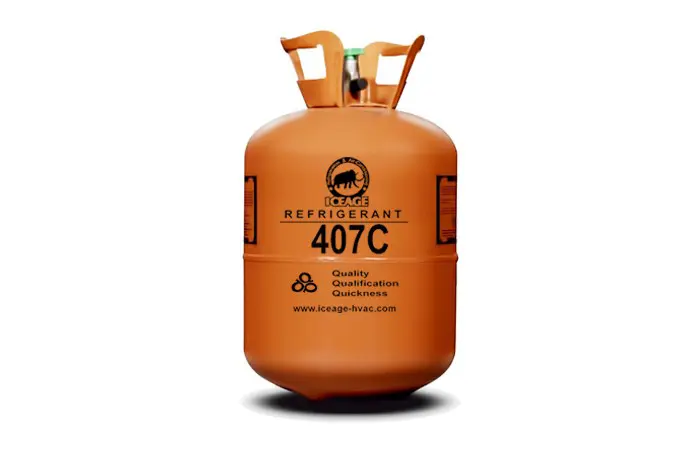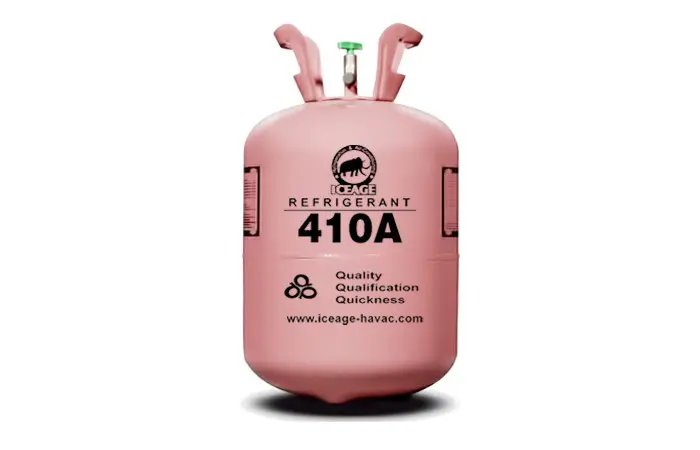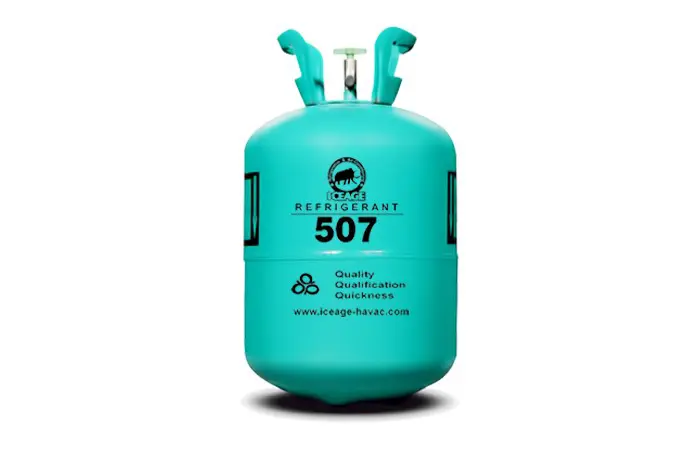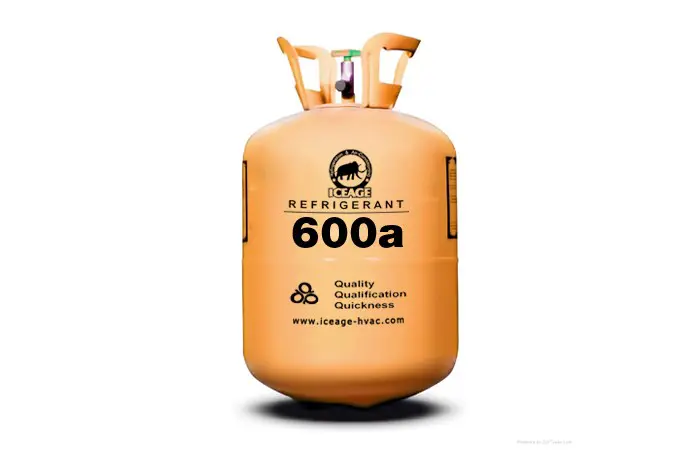refrigerant
 Refrigerant gas is a working fluid used in cooling systems such as air conditioners and refrigerators. It undergoes a repeated phase transition from a liquid to a gas and back again. Many refrigerants are man-made halogenated gases, especially fluorinated gases and chlorinated gases.Refrigerant gas can be harmful to human health and the environment if leaked or inhaled. It can cause refrigerant poisoning, which can cut off vital oxygen to your cells and lungs. It can also contribute to ozone depletion and global warming, as some refrigerants are potent greenhouse gases.
Refrigerant gas is a working fluid used in cooling systems such as air conditioners and refrigerators. It undergoes a repeated phase transition from a liquid to a gas and back again. Many refrigerants are man-made halogenated gases, especially fluorinated gases and chlorinated gases.Refrigerant gas can be harmful to human health and the environment if leaked or inhaled. It can cause refrigerant poisoning, which can cut off vital oxygen to your cells and lungs. It can also contribute to ozone depletion and global warming, as some refrigerants are potent greenhouse gases.
Refrigerant classifications
-
Natural refrigerants
Some refrigerants can be found in nature, most popular of them is R-744, or Carbon dioxide. The CO2 / R-744 is one of is one of the oldest refrigerants in the world used in air conditioning system. R-744 is considered as the perfect natural refrigerant as it is climate neutral and there is not a flammability or toxicity risk. However as a refrigerant R-744 has to run under extremely high pressure. As an example, R-744 operates at ten times higher pressure than R-134a.
-
CFC
R-12 was invented in 1935 and immediately after that date they exploded with popularity. CFC refrigerants were phased out in the 1990’s due to the Chlorine that they contained and the harmful effects that the Chlorine had on the Ozone layer.
-
HCFC
HCFC refrigerants are CFC refrigerant’s friendly cousin. These refrigerants are very similar and rose in popularity right about the same time as well. The most common HCFC refrigerant which I’m sure all of you have heard of is R-22. Just like it’s CFC cousin HCFC refrigerants were also phased out due to the Chlorine that they contained. The most recent phase out of R-22 is still going into effect and it will be completely phased out by 2030.
-
HFC
HFC refrigerants came around as an alternative to the Ozone damaging CFC and HCFC refrigerants. HFC refrigerants are widely used today. Some of the most popular ones are R-134a, R-404A, and R-410A. HFCs are actually in process of being phased out across the world as well but this time it’s not due to their Ozone depletion. Instead, they are being phased out due to their Global Warming Potential, or GWP.
-
Hydrocarbons
Hydrocarbons are a type of refrigerant that has been around for decades. They are naturally occurring elements rather than manufactured in a lab. Some Hydrocarbons include R-290 (Propane), R-600a (Isobutane), or R-1270 (Propylene). These refrigerants are used sparingly depending on the application needed. They are highly flammable and must be handled with care.
-
HFO or Hydrofluroolefin
HFO refrigerants are the newest and greatest thing. In an effort to replace the currently used refrigerant HFOs are designed to take the lead while the HFC refrigerants fade into the past. At this point in time, September 2017, the most popular HFO refrigerant is the 1234YF. Honeywell and the Chemours company are pushing the industry forward with their development of the new HFO line of refrigerants and we can expect many new refrigerants to be displayed over the coming years.
Refrigerant gas
HFC-134a, normally called R-134a, which is the most common refrigerant used in vehicle air conditioner systems. R-134a is currently the primary refrigerant used to retrofit CFC-12 systems. R-134a is a potent greenhouse gas with a global warming potential that is 1430 times that of CO2. And the use of R-134a in vehicle air conditioner systems accounts for an estimated 24% of total global HFC consumption. It is the most abundant HFC in the atmosphere. Globally, many automobile manufacturers are transitioning to the lower-GWP alternatives. None of these deplete the ozone layer and all have significantly lower impacts on the climate system than R‑134a.

R-404A is one of the most commonly used refrigerants in the world. You can find it most commercial refrigerators and freezers, in vending and ice machines, in industrial & commercial refrigeration applications. R-404A provided an immediate replacement product for both R-12, R-22 and R-502. This allowed the world to stop using Ozone depleting refrigerants. R-404A operated at comparable physical and thermodynamic properties that R-502 did which made transitioning to new systems or retrofitting older systems a much easier task. However, R-404A has extremely high Global Warming Potential (GWP). Its GWP rating is 3920. This number makes it one of the absolute highest GWP refrigerant that is widely used in the world today.

R-407C is one of the most preferred R-22 replacements since both refrigerants have similar characteristics when placed under certain conditions. However, R-22, even though it’s a safe and popular HCFC refrigerant, has negative effects on the ozone layer since it contains chlorine. Many countries worldwide signed a treaty (Montreal Protocol) in 1987 to phase out all refrigerants that contained Chlorine by the year 2020, and that’s where R407C came into the market. The R-407C refrigerant consists of three HFC (hydrofluorocarbons) components. They include R-32 (difluoromethane), R-125 (Pentafluoromethane), and R134A, also known as 1, 1, 1, 2- tetrafluoroethane. Additionally, the refrigerant is environmentally friendly since it has a Global Warming Potential of 1774 and a zero Ozone Depleting Potential. Although R-407C is a high-performance refrigerant, if released into the air, either via a leak or by accident, the fluorine in HFC refrigerants causes global warming. The other downside of R-407C is that you can only use it as a retrofit, not as an R22 drop-in. Most R22 retrofits are HFC blends that are not miscible with mineral oil. Hence, before adding the R-407C to your refrigerant, you need to remove the existing mineral oil and replace it with Poly Olester Oil (POE) to prevent the evaporator from overworking when trying to cool any space. You may also need to modify your system before adding the new refrigerant.

R-410A refrigerant offers higher cooling capacity and significantly higher pressure than R-22 for use in systems specifically designed for R-410A. This hydrofluorocarbon (HFC) refrigerant is compatible with POE oils and replaces R-22 in positive displacement air conditioning and heat pump systems for residential and light commercial applications. Regulations that limit and eliminate the use of R-22 have necessitated developing an alternative refrigerant. Using the non-ozone depleting, high efficiency R-410A replace R-22 offers several benefits: new equipment designed for R-410A can have up to 60% greater capacity than current R-22 equipment. Besides, new AC systems using R-410A can meet or exceed local energy performance guidelines

R-507 refrigerant is an azeotropic mixture of R-125 and R-143a with zero ozone depletion potential (ODP). It is a safe, effective alternative to some chlorofluorocarbon (CFC) and hydrochlorofluorocarbon (HCFC) refrigerants, including R-502. This hydrofluorocarbon (HFC) has similar qualities to R-502 and performs well in commercial refrigeration systems used in supermarkets or transport refrigeration where safety is paramount.

R-600a (Isobutane) is a refrigerant grade hydrocarbon gas that is environmentally friendly and highly efficient. R600a (Isobutane) is a hydrocarbon that is becoming increasingly popular due to its low Global Warming Potential (GWP). R-600a (Isobutane) has already been widely accepted in many parts of the world and will continue as various countries phase out HFC refrigerants such as R-404A and R-134a. Isobutane-based R-600a refrigerant has already begun to show up in home refrigerators, home freezers, commercial refrigerators, commercial freezers, vending machines, ice machines, and industrial refrigeration units.

FAQs
Reviews
